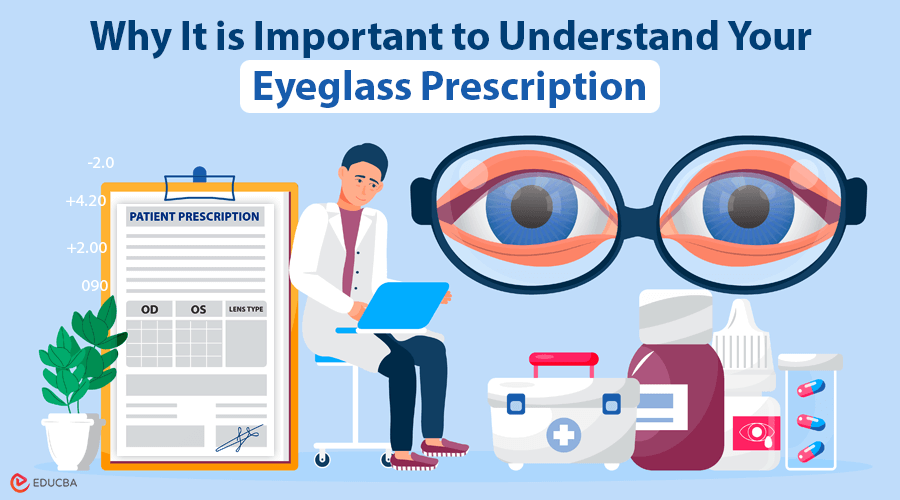What Is an Eyeglass Prescription?
An eyeglass prescription is a detailed set of instructions for creating lenses tailored to improve vision. It specifies whether you need assistance seeing far away, up close, or both. The prescription may also include corrections for conditions like astigmatism (when the shape of your eye is not perfectly round).
When you get an eye exam, your physician provides a piece of paper filled with numbers and letters. This is your eyeglasses prescription, detailing the type of lenses you need for clear vision. At first glance, it may seem confusing, but it is easy to understand once you know what each component means. Let us break it down step by step!
Parts of an Eyeglass Prescription
Eyeglass prescriptions are divided into several sections, each with a specific purpose. Here is what each part means:
1. OD and OS
- OD (Oculus Dexter) indicates the right eye, while OS (Oculus Sinister) indicates the left eye.
- Doctors use these Latin terms because they are easy to remember: OD means right, and OS means left.
2. Sphere (SPH)
- The sphere value indicates the lens power required
- A minus sign (-) means you are nearsighted and see better up close. A plus sign (+) means you are farsighted and see better at a distance.
3. Cylinder (CYL)
- The cylinder value shows how much correction is needed for astigmatism (when the eye is not perfectly round).
- If you do not have astigmatism, this section will be blank.
4. Axis
- The axis is a value ranging from 0 to 180. It specifies where to place the astigmatism correction on the lens.
- This number is essential for properly aligning the lens to fix astigmatism.
5. Add
- The add value is for people who need bifocals or progressive lenses.
- It indicates how much additional lens power is needed to help with close-up vision, such as reading or phone use.
6. Prism
- The doctor includes the prism value when correcting double vision.
- It helps align the images from both eyes, improving focus and coordination between them.
Example of an Eyeglass Prescription
Here is what a typical prescription might look like:
- OD: -2.00 SPH
- OS: -1.50 SPH, -0.75 CYL, Axis 120
This means:
- For your right eye (OD), you are nearsighted with a sphere power of -2.00.
- For your left eye (OS), you are slightly less nearsighted with a sphere power of -1.50. You also have astigmatism, which requires a cylinder correction of -0.75 at an axis of 120°.
Why It is Important to Understand Your Prescription
Knowing a way to read your eyeglass prescription is beneficial for several reasons:
- Buying Glasses: When you purchase glasses online or in-store, you must provide your prescription. Knowing how to read it ensures you get the right lenses.
- Tracking Changes: Your vision might change as you age. Comparing your prescriptions over time helps you see how much your vision has changed.
- Asking Questions: When you understand your prescription, you can ask your eye doctor informed questions about your vision health.
Common Myths About Eyeglass Prescriptions
There are several misconceptions about eyeglasses prescriptions that can lead to confusion. Let us debunk some of the most common myths:
Myth 1: Stronger glasses mean your eyes have gotten worse.
Not true! A stronger prescription means your eyes need more help to focus clearly, but it does not necessarily indicate a decline in your eye health.
Myth 2: You can use someone else’s prescription.
Every person’s eyes are unique, and using someone else’s prescription can cause eye strain and discomfort. Therefore, it is important to get a personalized prescription.
Tips for Managing Your Eyeglass Prescription
Managing your eyeglass prescription is crucial for maintaining optimal vision. Here are some helpful tips to ensure your prescription stays accurate and up-to-date:
- Keep a Copy: Always have a duplicate copy of your latest prescription in case you want new glasses.
- Get Regular Check-Ups: Visit your eye medical doctor at least once every 12 months to keep your prescription up to date.
- Know Your PD: The pupillary distance (PD) measures the distance between your pupils. It is essential for correctly fitting your glasses, so make sure to ask your doctor for it!
Final Thoughts
Reading your eyeglass prescription does not have to be complicated. It serves as a valuable guide that ensures your glasses tailor to your unique vision needs. If you ever feel confused, do not hesitate to ask your eye doctor for clarification—they are always happy to help! With the right glasses, you will see the world more clearly every day.
Recommended Articles
We hope this guide on eyeglass prescriptions helps you better understand how to read and interpret your prescription for optimal vision care. Check out these recommended articles for more insights on eye health and choosing the right eyewear.


